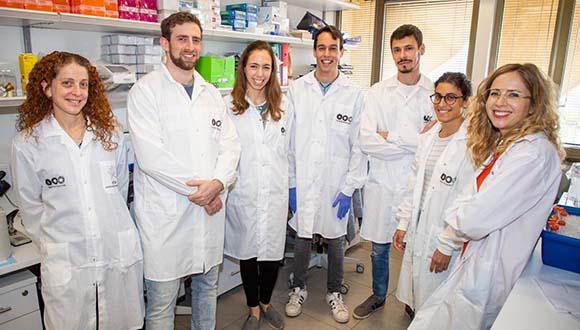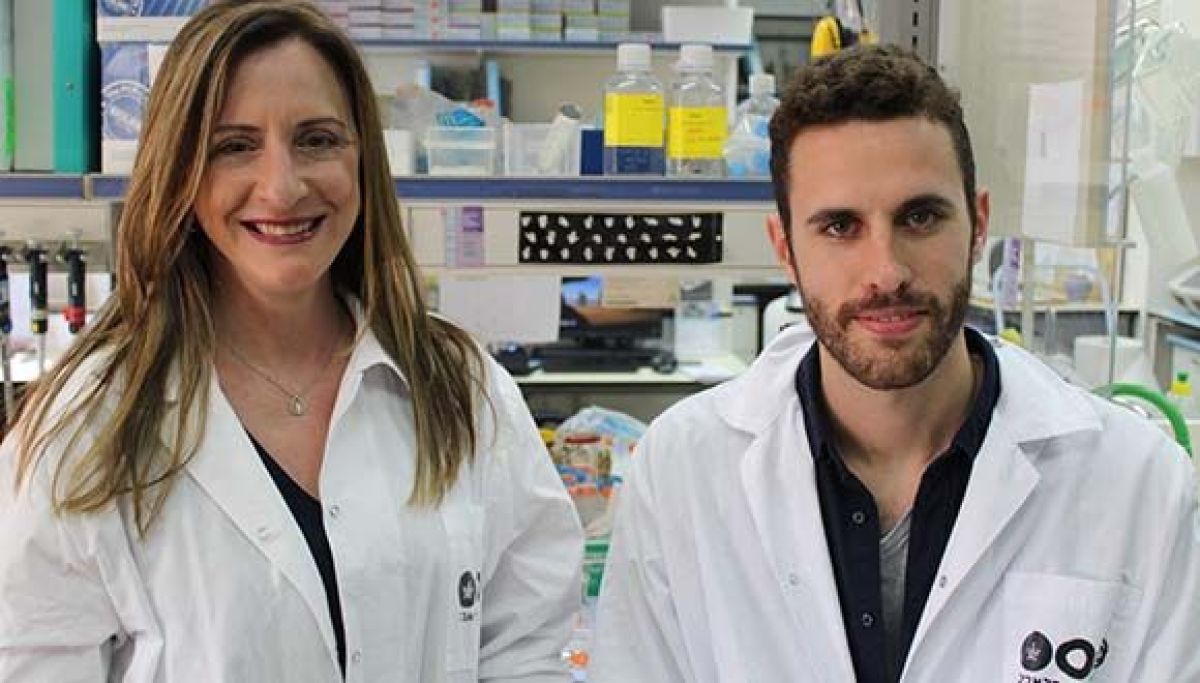Tag: Medicine
Could Your Smartphone Be Damaging Your Teeth?
Your FOMO may be compromising your physical and mental health.
More Screen Time = More Sufferings
The findings of the study show that 54% of secular smartphone users have a moderate to high incidence of night wakings, compared with only 20% among the ultra-Orthodox. In addition, half of the secular respondents (50%) feel a moderate to high level of stress due to the cell phone, compared to only 22% among the ultra-Orthodox. The disparities between the groups are also reflected in the question of how available they feel they need to be to their mobile devices – 45% of the secular respondents answered that they had a moderate to high need to be available to their phones, compared to only 20% in the ultra-Orthodox group. These gaps are even more marked when examining damage to the chewing muscles and jaw joints: 45% of the secular group reported teeth-grinding (24% during the day and 21% at night) and 29% of them claimed that they suffered pain in their jaw muscles, in comparison to only about 14% of the ultra-Orthodox who described these symptoms (13.5% reported teeth-grinding and 14% pain in the jaw muscles). Dr. Friedman-Rubin and Prof. Eli explain that “In today’s day and age people live with a sense of FOMO (fear of missing out) and so they want to stay constantly updated and know ‘what’s new’ every moment. This need naturally creates a growing dependence on cell phones, which leads to feelings of stress and anxiety – ‘someone might write something on social media and I’ll miss it and not be in the loop.’” Dr. Friedman-Rubin explains, “The current study has demonstrated a link between the excessive use of smartphones that enable surfing on social apps and a significant increase in night wakings (which lead to fatigue during the day), facial and jaw pain, tightness in the jaw during the day and teeth-grinding at night – physical symptoms that are often the result of stress and anxiety and which may even lead to physical injury such as dental erosion and joint damage. We are of course in favor of technological progress, but as with everything in life, the excessive use of smartphones can lead to negative symptoms, and it is important that the public be aware of the consequences it has on the body and mind.”COVID-19 Vaccinations at TAU
400 students received their second COVID-vaccine on campus this month.
Gradual Return to Campus
Maureen shares that “vaccines were made available to all those of our students who wanted to be vaccinated, including to students from the Palestinian Authority. After a full year of Corona, we miss all of our students, and look forward to a return to campus life in accordance with the ‘Green Pass’ directives.” TAU International have students from all over the world, including India, Colombia, Brazil, China, the USA, England, France, Germany, Australia, and Japan. Many of the international students expressed joy and gratitude for the opportunity to get vaccinated. Paola Gutiérrez from Columbia, is one of TAU’s international students. She arrived in Israel five months ago and is studying for her master degree in biochemistry. She tells us that her stay in Israel has been great so far, but she is happy that things are opening up again after the lockdown. In the video below, Paola had just received her 2nd jab of the Covid-19 vaccine. She tells us she’s the first among her friends (back in Columbia) to get fully vaccinated.Covid-19 Vaccination of Nursing Mothers May Protect Babies
Promotes production of important antibodies in breast milk.
We may have some good news: Covid-19 vaccination of nursing mothers might actually work to protect not only them, but their babies as well. This was found in a new study conducted jointly by Tel Aviv University and the Tel Aviv Sourasky Medical Center – Ichilov, in order to find out whether Pfizer’s COVID-19 vaccine was effective in producing antibodies in breast milk, and also to determine the qualities of these antibodies (whether they have the potential to neutralize the virus). The study was conducted during the months January and February 2021, shortly after the vaccines arrived in Israel, and included 10 breastfeeding mothers. The volunteers received two shots of the vaccine, 21 days apart, and the levels of antibodies in both their blood and breast milk were tested at four points in time, following vaccination. Blood and breast milk, it was found, are well synchronized with regard to the rise of the levels of the specific antibodies generated by the vaccine. In both blood and breastmilk, the significant increase occurs 14 days after the first shot, and continues 7 days after the second shot. The antibodies that develop in breastmilk hold the potential to neutralize the virus, and thus prevent the disease, by blocking the virus from binding with receptors on host cells. The leading research team at Tel Aviv University included Dr. Yariv Wine and the PhD student Aya Kigel from the Shmunis School of Biomedicine and Cancer Research at the Faculty of Life Sciences. The team at the Lis Maternity and Women’s Hospital at the Tel Aviv Sourasky Medical Center was led by Dr. Michal Rosenberg-Friedman and Prof. Ariel Many. The paper is currently undergoing peer review and can be read here >>The Quest for A Lifesaving Cure
Innovative technology of BLAVATNIK CENTER for Drug Discovery may save boy suffering from rare neurological syndrome.
In December 2019, the BLAVATNIK CENTER for Drug Discovery at Tel Aviv University was presented with a challenge which demanded flexibility and thinking outside the box. Prof. Ehud Gazit, Founder and Academic Director of the BLAVATNIK CENTER for Drug Discovery at Tel Aviv University, received an email from Scott Reich, a very worried father. Scott’s son Eli, only eight months old at the time, had just been diagnosed with the ultra-rare FOXG1 syndrome, a neurological disorder that severely impacts brain development. With only about 700 known cases worldwide, predominantly children with severe disabilities, this devastating condition attracts little research and has no cure. Determined to save his son, Scott searched all over the world for experts who could develop a treatment for the rare syndrome. The advice and recommendations of leading scientists and health professionals led him to the BLAVATNIK CENTER at TAU in Israel, which specializes in the field of drug repurposing: repurposing FDA-approved medications and other safe substances to help people with rare diseases, all too often overlooked by the big pharmaceutical companies. Dr. Eddy Pichinuk, Head of the HTS and Biological Assays Unit at BLAVATNIK CENTER, whose team was already conducting research for several other families affected by rare diseases, willingly accepted the new challenge. Dr Pichinuk and his team quickly obtained a sample of Eli’s cells, which had been deposited in a biobank for rare disease biosamples, and established a personalized drug-screening platform to test these cells against known, safe, FDA-approved molecules that could be repurposed. Essentially, they were looking for any drug (originally developed for some other purpose) that would increase the amount of FOXG1 protein in Eli’s brain, making up for the damaging deficiency caused by the mutation. The researchers were well aware that this might be Eli’s only hope for a more normal life: once a safe and effective drug is identified, it can be repurposed to offer Eli and others like him compassionate treatment. “Our screening platform is based on a luminescent protein, expressed in fireflies, that replaces the faulty protein in Eli’s cells,” explains Eddy. “We are screening a library of about 7,000 FDA-approved substances, initially developed to treat a range of diseases, such as cancer, psychiatric disorders, or various inflammatory syndromes. By testing each drug’s interaction with the marked protein in Eli’s cells, we have so far discovered several potentially helpful drug candidates. As we begin to see the light at the end of the tunnel, we continue to search for additional drugs.” In the next stage, the researchers will use advanced methods of genetic engineering to transform skin samples from Eli and his parents into stem cells and then into neurons. Ultimately, they will test the effect of the chosen drugs on Eli’s neurons. Determined and optimistic, they aim to restore more normalized brain development.Thinking Outside the Box
Dr. Avi Raveh, the BLAVATNIK CENTER’s Chief Scientific Officer, explains that the Center offers a unique research approach, applying personalized medicine methodology to rare diseases. “We respond to requests from families all over the world, often at the last moment before they lose hope. Unlike large research institutions, we resemble a small and dynamic startup, eliminating or speeding up any bureaucracy and getting right down to the crux of the challenge. In Eli Reich’s case, with the time window for brain development closing fast, this flexibility is crucial. I truly hope that we can help him.” “Coming to Israel and working with the BLAVATNIK CENTER has been a good experience so far,” says Scott. Thanks to the Israeli spirit of collaboration, researchers at the Weizmann Institute of Science and Ben-Gurion University of the Negev have also been recruited to join the mission of saving Eli. He remains hopeful: “When we heard the devastating diagnosis, I said to my wife Ilissa: ‘We have to go to Israel. In Israel, we’ll find the know-how, experience and out-of-the-box thinking that we need.’ Reaching out through the American Jewish community and our Israeli friends, we got in touch with the BLAVATNIK CENTER for Drug Discovery, and immediately felt at home. The team is very creative, they work fast and are sincerely dedicated to finding a treatment for FOXG1 syndrome – they’re not just looking to publish a paper in a scientific journal. For us, this genuine commitment is extremely important. The BLAVATNIK CENTER team is doing everything they can so that Eli and others with FOXG1 Syndrome may live and hopefully enjoy more productive lives.” For more information about FOXG1 and Eli Reich, please visit BELIEVE IN A CURE Featured image: The Reich FamiliyA Healthier Alternative to Antibiotics
New study proves biological treatment can be a suitable alternative to antibiotics.
In a groundbreaking new study led by Dr. Natalia Freund and doctoral candidate Avia Watson at the TAU Sackler Faculty of Medicine, researchers were able to develop a “biological antibiotic” and demonstrates that human antibodies can offer an alternative to the traditional chemical antibiotics. The study was conducted in collaboration with laboratories in the United States and China and published in the prestigious scientific journal Nature Communications.
During the past century, antibiotics have served as the main treatment against bacteria, being both efficient and cheap. Antibiotics are chemical agents, designed to block and destroy specific cells, such as microbial cells. However, since some biological mechanisms are common to both human and microbial cells, the range of antibiotics that can safely be used without harming the patient is limited. For example, cell wall components of many strains of microbes are common to human cells; therefore, any damage caused to the microbial cell walls can lead to extensive damage to body systems. Furthermore, in recent years the number of microbial strains that are resistant to existing antibiotics has grown, which presents new challenges of defending the body from microbes in the post-antibiotic era.
For these reasons, Dr. Natalia Freund and her laboratory team have spent the recent years searching for a biological alternative to known antibiotics. Dr. Freund explains, “Advances in biological medicine have enabled us to rout the germs in new ways that are not based solely on antibiotics, allowing for a solution to the challenge posed by resistant germs. Our study is an initial proof of the concept of employing monoclonal antibodies (derived from single cells) as an effective therapy for combating bacterial pathogens”. Antibodies are proteins that are produced naturally by our immune response following infection or a vaccine. They harbor many advantages such as specificity, stability and safety. This is why antibodies are today in widespread use in the clinic for treatment of cancer, autoimmune diseases and viral infections such as COVID-19.
Tuberculosis as Test Case
The research team chose Tuberculosis, which is caused by infection of the bacilli Mycobacterium tuberculosis, as a test case and were able, for the first time ever, to create an effective treatment based on anti-bacterial antibodies that developed naturally during infection (the antibodies were extracted from a patient who had been infected, and has since recovered, from tuberculosis). Another reason for the choice of tuberculosis is that although the vaccine against tuberculosis was developed 100 years ago (and is based on the attenuated bacillus bovis (BCG) strain), it is not effective for adults and does not prevent infection. In addition, in recent years, more and more strains of disease have developed that are resistant to the only treatment currently available: treatment with antibiotics. Since tuberculosis bacteria are highly contagious and are transmitted through the air and damaging to the lungs, the spread of untreated resistant strains of tuberculosis constitutes a real hazard. Today, about a quarter of the world’s population is infected with tuberculosis, with the rates of drug-resistant strains peaking as high as 40% in some countries. In Israel, there are about 200 active tuberculosis cases every year.
Dr. Natalia Freund and her research team
Future Targets: Pneumonia and Staphylococcal Infections
Due to the size and complexity of the tuberculosis bacillus, previous efforts to isolate monoclonal antibodies against it have been futile. The researchers in Dr. Freund’s laboratory have succeeded in isolating two types of antibodies which contributed to a 50% reduction of the bacterial levels in mice relative to other mice that were not treated with antibodies. These antibodies have been found to be effective against three different strains of the tuberculosis bacterium and are expected to be effective also against additional strains that have not yet been investigated, including strains that are resistant to antibiotics
Following the success of the study, Dr. Freund’s laboratory is currently exploring the possibility of extending the “biological” substitute for antibiotics to include other diseases. “The demonstrated case for this study will enable us to expand on our future work to include diseases such as pneumonia and staphylococcal infections,” says Dr. Freund.
Children with Autism during Lockdown: Serious Implications for Behavior and Development
A new TAU study examines the difficulties experienced by children with different levels of autism and their parents during Israel’s first lockdown during the coronavirus crisis (in the spring of 2020). The data shows that the drastic changes in the children’s routines and their prolonged stay in their homes instead of their special education had serious implications for the behavior and development of the children and impacted their parent’s ability to support them
The study was led by Dr. Itay Tokatly-Latzer, Prof. Orit Karnieli-Miller and Prof. Yael Leitner from the TAU Sackler Faculty of Medicine, in collaboration with the Tel-Aviv Sourasky Medical Center, and was published in the academic journal ‘Autism’.
Lack of Routine Caused Regression
The study group consisted of the parents of 25 children with autism who shared the difficulties they faced during lockdown with the researchers in real time. Some children would for instance refuse to go to sleep at night – screaming and restless, they would stay awake all through the night. Others experienced behavioral regression, returning to repetitive and stereotypical movements that had initially improved.
At the same time, however, the researchers note that there were families who experienced it differently and who found creative ways to help their children get through the crisis in a positive way: One couple chose to go along with the particular interests of their child, engaging in repetitive cake baking. The parents of another child who needed to be in constant movement, bought their son a trampoline so that he could spend his excess energy inside their home.
Support and Guidance Programs for Parents of Children with Autism
Prof. Karnieli-Miller: “Lockdowns are difficult for all of us, but all the more so for families with autistic children. For these children, even the slightest change of routine can cause harm and throw them off balance. The study showed that in many instances the parents were left helpless as they did not have the tools and the professional knowledge required to deal with the situation. The parents need to be given the tools, support and guidance in order to deal with this huge challenge and enable them to create a ‘flexible routine’ for their children.
“The findings of the study show that during periods of lockdowns the State must do whatever it takes to prevent the closing down of special education, in order to prevent causing harm to children with special needs. If the State nevertheless decides that such steps be taken, it must immediately implement assistance and guidance programs for parents of children with autism. The parents need to receive professional help and better tools for caring for their children.”
Cancer Breakthrough: Cells’ Uniqueness is Also Weakness
TAU research proves connection for first time, can be base for cancer drugs.
What makes cancer cells different from ordinary cells in our bodies? Can these differences be used to strike at them and paralyze their activity? This basic question has bothered cancer researchers since the mid-19th century. The search for unique characteristics of cancer cells is a building block of modern cancer research. A new study led by researchers from Tel Aviv University shows, for the first time, how an abnormal number of chromosomes (aneuploidy) — a unique characteristic of cancer cells that researchers have known about for decades — could become a weak point for these cells. The study could lead, in the future, to the development of drugs that will use this vulnerability to eliminate the cancer cells.
The study, which was published in Nature, was conducted in the laboratory of Dr. Uri Ben-David of the Sackler Faculty of Medicine at Tel Aviv University, in collaboration with six laboratories from four other countries (the United States, Germany, the Netherlands, and Italy).
Aneuploidy is a hallmark of cancer. While normal human cells contain two sets of 23 chromosomes each — one from the father and one from the mother — aneuploid cells have a different number of chromosomes. When aneuploidy appears in cancer cells, not only do the cells “tolerate” it, but it can even advance the progression of the disease. The relationship between aneuploidy and cancer was discovered over a century ago, long before it was known that cancer was a genetic disease (and even before the discovery of DNA as hereditary material).
According to Dr. Ben-David, aneuploidy is actually the most common genetic change in cancer. Approximately 90% of solid tumors, such as breast cancer and colon cancer, and 75% of blood cancers, are aneuploid. However, our understanding of the manner in which aneuploidy contributes to the development and spread of cancer is limited.
In the study, the researchers used advanced bioinformatic methods to quantify aneuploidy in approximately 1,000 cancer cell cultures. Then, they compared the genetic dependency and drug sensitivity of cells with a high level of aneuploidy to those of cells with a low level of aneuploidy. They found that aneuploid cancer cells demonstrate increased sensitivity to inhibition of the mitotic checkpoint – a cellular checkpoint that ensures the proper separation of chromosomes during cell division.
They also discovered the molecular basis for the increased sensitivity of aneuploid cancer cells. Using genomic and microscopic methods, the researchers tracked the separation of chromosomes in cells that had been treated with a substance that is known to inhibit the mitotic checkpoint. They found that when the mitotic checkpoint is perturbed in cells with the proper number of chromosomes, cell division stops. As a result, the chromosomes in the cells separate successfully, and relatively few chromosomal problems are created. But when this mechanism is perturbed in aneuploid cells, cell division continues, resulting in the creation of many chromosomal changes that compromise the cells’ ability to divide, and even cause their death.
The study has important implications for the drug discovery process in personalized cancer medicine. Drugs that delay the separation of chromosomes are undergoing clinical trials, but it is not known which patients will respond to them and which will not. The results of this study suggest that it will be possible to use aneuploidy as a biological marker, based on possibility to find the patients who will respond better to these drugs. To put it another way, it will be possible to adapt drugs that are already in clinical trials for use against tumors with specific genetic characteristics.
In addition, the researchers propose focusing the development of new drugs on specific components of the mechanism of chromosomal separation, which were identified as especially critical to aneuploid cancer cells. The mitotic checkpoint is made up of several proteins. The study shows that the aneuploid cells’ sensitivity to inhibition of the various proteins is not identical, and that some proteins are more essential to cancer cells than others. Therefore, the study provides motivation for developing specific drugs against additional proteins in the mitotic checkpoint.
“It should be emphasized that the study was done on cells in culture and not on actual tumors, and in order to translate it to treatment of cancer patients, many more follow-up studies must be conducted. If they hold true in patients, however, our findings would have a number of important medical implications,” Dr. Ben-David says.
The study was conducted in collaboration with laboratories from five countries: Dr. Zuzana Storchová, (Technische Universität Kaiserslautern, Germany), Dr. Jason Stumpff (University of Vermont, USA), Dr. Stefano Santaguida (University of Milano, Italy), Dr. Floris Foijer (University of Groningen, the Netherlands), and Dr. Todd Golub (The Broad Institute of MIT and Harvard, USA).
Academic First Responders
How TAU sparked a learning revolution in the wake of COVID-19.
By Idit Nirel
When COVID-19 broke in Israel in mid-March and the country shut down, Tel Aviv University (TAU) decided to continue teaching all courses online—almost overnight.
While many professors and students struggled to adapt, Prof. Guy Mundlak was ready.
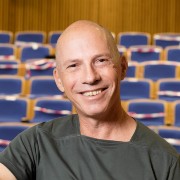
Prof. Guy Mundlak. Photo: Yoram Reshef.
Mundlak, who teaches both at the Buchmann Faculty of Law and the Department of Labor Studies of the Gordon Faculty of Social Sciences, made the change to online teaching 4 years ago. One of his courses, “Labor Law,” is a hybrid course; students study theoretical materials on their own through online videos of lectures, and the in-person sessions are dedicated to discussions and analyzing the latest case studies. Mundlak’s motivation to go digital preceded COVID-19 and stemmed from a different reason:
“Teaching this course for over 20 years, I couldn’t reinvent the wheel and find new ways to teach the same material every time,” he says. Making the course digital refreshed it.
Mundlak sees online learning not as a constraint, but as an opportunity: “The format allows students to learn the general concepts at their own pace, and I can focus my classroom lessons on what interests us here and now, without worrying if I’ve covered all of the material in time for the exam,” he explains. “This approach leaves me more room for spontaneity, for dealing with matters of the hour, and for diving deep into topics with the students. As a result, I don’t just lecture to my students; I engage and involve them in issues that touch their everyday lives—which is the best way to learn.”
With the pandemic and lockdown crushing the economy, Mundlak’s course became especially relevant to his students in the spring of 2020. He dedicated his classes—taught via Zoom—to employment issues that emerged during the Corona pandemic, such as the ramifications of layoffs and furloughs. Because most of his students had been working as waiters or in other hourly jobs to finance their studies, these subjects were not just academic theory, but reality, for many of them.
Coronavirus Pushes Learning Online
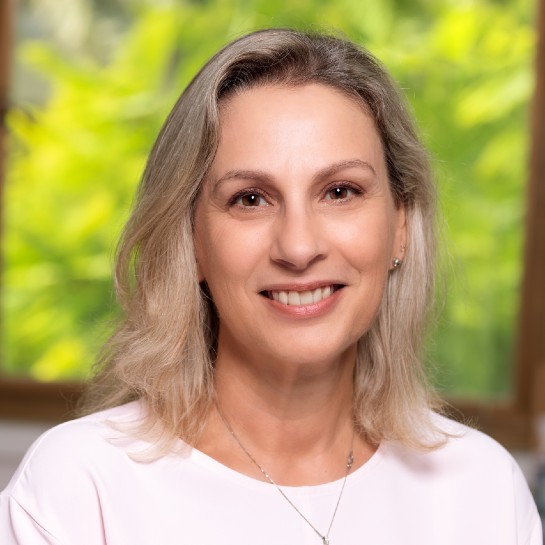
Dr. Tal Soffer. Photo: Yoram Reshef.
Providing Prof. Mundlak with digital tools for online teaching was Dr. Tal Soffer, Director of Virtual TAU, the unit responsible for enhancing the University’s digital teaching capacity and resources. According to her, “online courses or integrating digital methods into other courses allow for learning that is customized to students’ needs.” At the same time, “online learning can provide students with skills for lifelong learning, which are crucial for success in today’s labor market—such as time management and the ability to learn independently.”
As Coronavirus spread in Israel and lockdown appeared imminent, Soffer and her team were already working around the clock to facilitate the shift to online studies. It was a success. More than 90,000 live online lessons took place over the spring semester, in addition to thousands of lessons recorded for independent study. All in all, online learning during the lockdown accounted for more than 50,000 hours and 10 Terabits in digital volume.

TAU student Michal Ferenz. Photo: Yoram Reshef.
Soffer and her team set up a technical support hotline for online learning; they received as many as 700 calls per day. In addition to assisting professors in overcoming the technicalities of online teaching, the team also created more than 50 video guides showing lecturers how to use online learning tools to make lessons more engaging.
The team also conducted large-scale surveys among 7,000 students and 750 faculty members. They found that a vast majority of students wanted to incorporate online learning into their studies in the future.
Like other universities around the world, TAU also faced the new challenge of conducting online exams and evaluations. Spring semester exams were conducted from home with supervisors overseeing students through Zoom.
During the 2020-2021 academic year, TAU is introducing a pilot computerized authentication system for online exams. The new technology will secure online exams by verifying students’ identity and monitoring their presence and activities during the exam. Although this is a big step forward, Soffer is aware that in the long run adopting more of these technologies may be intrusive. Instead of relying on anti-cheating applications, Soffer says, the University should also encourage alternative evaluation methods, such as essays and group projects.
“The Corona crisis profoundly disrupted higher education and forced it to make the transition to the digital world—and, in a way, I believe this is exactly the kind of disruption that was needed. The question is, how do we move forward from here?” Soffer says.
Innovating on all Levels
“Universities all around the world understood a long time ago that they have to transform learning and to enhance their online and digital tools,” says Yuval Shreibman, Director of TAU Online – Innovative Learning Center. The Center started producing online courses long before Corona to make academia more accessible through technology.
“COVID-19 caused us to leap forward and address problems that we could previously overlook. At the same time, it shows us that we need to make complementary classroom learning more active and engaging.”
Given the volatile reality and constantly changing regulations, TAU prepared for all possible scenarios for the new academic year. While it intended to offer first-year students the option to physically attend classes, studies were conducted online for the duration of the first semester. In response, Virtual TAU has launched an unprecedented effort to arm lecturers with versatile presentation tools and introduce additional courses that are fully online.
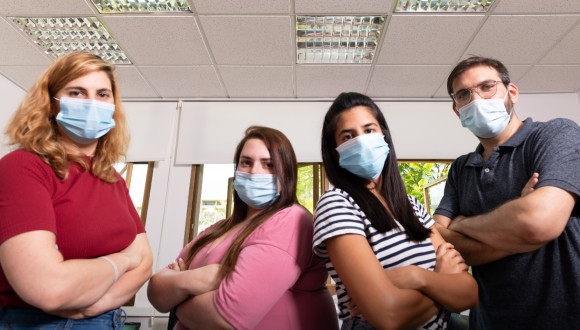
Virtual TAU Team. Photo: Yoram Reshef.
Admissions to the University are also going online, with a new admissions track based on participation and success in specific online courses chosen by each faculty. The new track is currently intended for candidates who, because of COVID-19, could not take standardized university admissions tests. Yet, it also provides greater access to the University for young Israelis from disadvantaged backgrounds or outlying communities, who otherwise might not be able to study at TAU.
In the fall of 2021, TAU plans to launch a new fully online international MBA program, the first of its kind to be offered by an Israeli university. It will combine video courses that students will watch independently, with personal guidance from teaching staff, online study forums and projects. Based on the same high entrance requirements as the regular MBA programs at TAU’s Coller School of Management—recently ranked as the 13th school in the world for producing VC-backed entrepreneurs—the program is expected to attract ambitious students from across the globe.
COVID-19 underlined the importance of online learning at TAU so much that President Ariel Porat created a new position to oversee educational innovation; Prof. Liat Kishon-Rabin became Dean of Innovation in Learning and Teaching in July. “TAU has always prided itself as a leader in educational innovation, but the Corona pandemic has highlighted the need to focus on this field even more,” says Prof. Porat. “I trust that Prof. Kishon-Rabin will build on our existing achievements and lead us through the post-Corona era with vision and success.”
Read about Minducate, an innovation and learning center at TAU.
Providing Critical Support during Online Learning
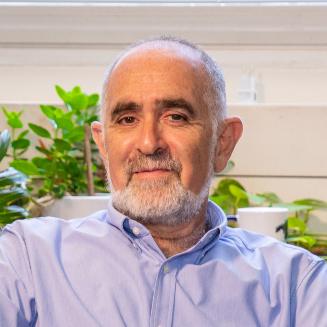
Alberto Meschiany. Photo: Moshe Bedarshi.
Despite the positive insights gleaned about online learning, TAU must take into account students who struggled with remote learning as it prepares for a new academic year in the shadow of COVID-19. Alberto Meschiany, Head of the Psychological Services Unit at TAU’s Student Services Division, says that at the beginning of the crisis, his unit experienced a 15% rise in requests for psychological support.
“For many students, the anxiety resulting from the pandemic itself and its economic implications was coupled with the stress of having to study and take exams from home,” he says. “For students who live in the dorms or come from lower socio-economic levels this was exceptionally difficult. Many of them don’t have a quiet place to study. Some live in remote towns that don’t have the Internet network to support continuous online studies.”
Yet, according to Meschiany, it isn’t only the logistical and technological barriers that made the shift to online learning difficult for many TAU students. “Distance from other students can create feelings of alienation and loneliness. All the technology in the world cannot replace the support that students get from their peers,” he says. “In addition, the lack of a personal lecturer-student relationship has a negative effect on academic development. The ability to knock on a lecturer’s door and ask a question or discuss a topic spontaneously is lost with online learning.”
Meschiany believes that as the University adopts more online learning methods, it should make an effort to tailor them to accommodate students with various difficulties. “They will need our active help,” he says.
The Student Viewpoint
Looking back at lessons learned from the “first wave” of online learning, there is no question that TAU can learn the most from its students. Jonathan Berkheim, a master’s student in chemistry and spokesperson for TAU’s Student Union when the pandemic started, experienced the lockdown and its aftermath from several perspectives.
As a senior member of the Student Union, he fielded numerous calls from students who struggled to study within the new framework. Even students who fared well felt shortchanged, according to Berkheim. “The social interaction, class discussions and campus life are crucial parts of the package that students expect from university studies.”
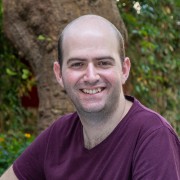
Jonathan Berkheim. Photo: Moshe Bedarshi.
At the same time, Berkheim says that the unusual circumstances broke traditional, hierarchical barriers between students and professors. They found themselves communicating directly on WhatsApp groups, saw each other’s homes during Zoom sessions, and shared similar experiences of life during the lockdown. “I hope that the University will embrace this new paradigm for student-professor relations in the future.”
In addition, as a teaching assistant, he experienced distance learning from the other side of the virtual podium: “Something gets lost in translation. Students get distracted more easily. It was hard for me to know if they really understood what I was teaching.”
Finally, as a student himself, he found that watching recorded lessons at his own pace was convenient. “Face-to-face learning in the classroom is crucial, but combining it with independent online studies will have great benefits for students,” Berkheim concludes.
Among TAU students studying remotely are also hundreds of international students from over 100 countries, who are enrolled in over 60 English-led academic programs offered by TAU International. In the midst of the crisis, TAU International launched an online summer course, titled: “COVID-19: From Crisis to Opportunity,” which attracted more than 80 participants from Asia, South America, North America and Europe.
Read about how TAU Impact, the University’s flagship community service program, adapted to the pandemic.
As TAU heads toward another academic year, it is clear that life with COVID-19 has become the new normal. All players involved in online learning understand that TAU must embrace the advantages moving forward.
“Until recently, when I was presenting my own field of research—which deals with future trends in the labor market and predicts that people would increasingly shift to working from home—people would tell me that it sounds too futuristic,” says Prof. Mundlak. “Now it is has become a reality. The future is here.”
Featured image: TAU Life Sciences Prof. Nir Ohad films a remote lecture at the TAU Online studio. Photo: Yoram Reshef.
TAU Scientists Develop Innovative Therapy to Prevent Deafness
The treatment is inserted into the ear, prevents hearing loss caused by a genetic mutation.
A new study at Tel Aviv University presents an innovative treatment for deafness, based on the delivery of genetic material into the cells of the inner ear. The genetic material ‘replaces’ the genetic defect and enables the cell to continue functioning normally.
The scientists were able to prevent the gradual deterioration of hearing in mice with a genetic mutation for deafness. They maintain that this novel therapy could lead to a breakthrough in treating children born with various mutations that eventually cause deafness.
The study was led by Prof. Karen Avraham and Shahar Taiber, a student in the combined MD-PhD track, from the Department of Human Molecular Genetics and Biochemistry at the Sackler Faculty of Medicine, and the Sagol School of Neuroscience, and Prof. Jeffrey Holt from Boston Children’s Hospital and Harvard Medical School. Additional contributors included Prof. David Sprinzak from the School of Neurobiology, Biochemistry and Biophysics at the George S. Wise Faculty of Life Sciences at Tel Aviv University. The paper was published in EMBO Molecular Medicine.
Deafness is the most common sensory disability worldwide. According to the World Health Organization there are about half a billion people with hearing loss around the world today, and this figure is expected to double in the coming decades. One in every 200 children is born with a hearing impairment, and one in every 1,000 is born deaf. In about half of these cases, deafness is caused by a genetic mutation. There are currently about 100 different genes associated with hereditary deafness.
Prof. Avraham: “In this study we focused on genetic deafness caused by a mutation in the gene SYNE4 – a rare deafness discovered by our lab several years ago in two Israeli families, and since then identified in Turkey and the UK as well. Children inheriting the defective gene from both parents are born with normal hearing, but gradually lose their hearing during childhood. This happens because the mutation causes mislocalization of cell nuclei in the hair cells inside the cochlea of the inner ear, which serve as soundwave receptors and are thus essential for hearing. This defect leads to the degeneration and eventual death of hair cells.”
Shahar Taiber: “We implemented an innovative gene therapy technology: we created a harmless synthetic virus and used it to deliver genetic material – a normal version of the gene that is defective in both the mouse model and the affected human families. We injected the virus into the inner ear of the mice, so that it entered the hair cells and released its genetic payload. By so, we repaired the defect in the hair cells, and enabled them to mature and function normally.”
The treatment was administered soon after birth and the mice’s hearing was then monitored using both physiological and behavioral tests. Prof. Holt: “The findings are most promising: Treated mice developed normal hearing, with sensitivity almost identical to that of healthy mice who do not have the mutation”. Following the successful study, the scientists are currently developing similar therapies for other mutations that cause deafness.
Prof. Wade Chien, MD, from the NIDCD/NIH Inner Ear Gene Therapy Program and Johns Hopkins School of Medicine, who was not involved in the study, illuminates its significance: This is an important study that shows that inner ear gene therapy can be effectively applied to a mouse model of SYNE4 deafness to rescue hearing. The magnitude of hearing recovery is impressive. This study is a part of a growing body of literature showing that gene therapy can be successfully applied to mouse models of hereditary hearing loss, and it illustrates the enormous potential of gene therapy as a treatment for deafness.
The study was supported by the BSF – US-Israel Binational Science Foundation, the NIH – National Institutes of Health, the ERC – European Research Council, and the Israel Precision Medicine Partnership Program of the Israel Science Foundation.







